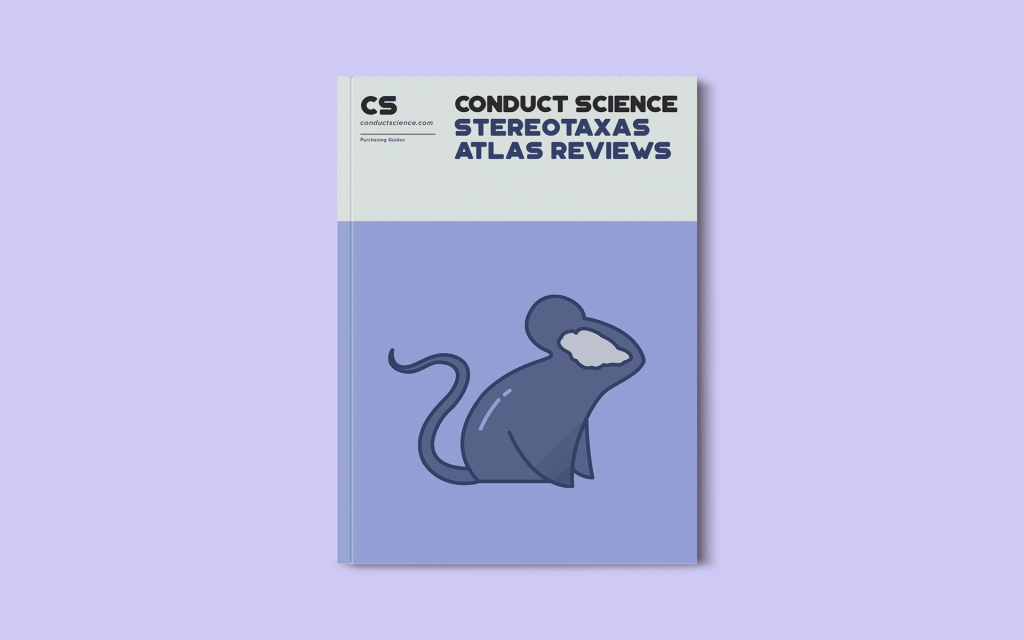

The stereotaxic approach of a target structure in the rodent brain requires sufficient theoretical knowledge on the specific locations of different brain regions. The stereotaxic atlas, a necessity in stereotaxic procedures, provides the layout of the rodent brain through theoretical coordinates for the implantation of cannulae, electrodes, and other instruments.
Given that an important element of the stereotaxic procedure is the accurate quantification of internal and external distances in preparation for rodent surgery, stereotaxic atlases provide the precise coordinates for particular brain regions along the three orthogonal planes. The three adjustable vernier screwdrivers in the stereotaxic apparatus, which deliver accurate quantification of distances, are moved along these three planes, namely–the anteroposterior (AP) axis, running from the anterior to the posterior part of the animal’s head; the mediolateral (ML) axis, running along the midline to the right or left side; and the dorsoventral (DV) axis, running from the surface of the skull to the brain’s interior.
In targeting particular brain structures, these stereotaxic coordinates given along the anteroposterior, mediolateral, and dorsoventral planes are calculated with respect to two distinct reference points on the surface of the animal’s skull; the bregma and lambda. It is the researcher’s responsibility to choose the appropriate reference point based on the target structure’s location. Usually, the closest reference point to the target structure is chosen. For instance, if the target structure is the hippocampus, the bregma may be recommended as a landmark as opposed to the lambda.
Many stereotaxic atlases have been published, each catering to differences in rodent species as well as animal body weight, sex, strain, and age. It is, therefore, the researcher’s responsibility to take all of these principal factors into consideration in the preliminary process of choosing the appropriate reference material for the duration of the experiment. It should be noted that stereotaxic atlases do not necessarily use the same cartographic parameters, and in using multiple atlases, one must use parameters valid only for the particular material. Cited below are some of the rodent stereotaxic atlases that have been in use by researchers since the advent of stereotaxic surgery. The different authors of these atlases have provided infinitely beneficial reference tools, with different features that serve specific purposes.
The earliest material made available for stereotaxic procedures on the mouse was Sidman, Angevine, and Taber’s (1971) Atlas of the Mouse Brain and Spinal Cord, and Montemurro and Dukelow’s (1971) Stereotaxic Atlas of the Diencephalon and Related Structures of the Mouse. These two books paved the way for the development of more reference materials for stereotaxic surgery in mice.
The Allen Brain Atlas is a mouse brain anatomical atlas and gene expression database that’s made available online. This online reference tool includes both coronal and sagittal views of the mouse brain, presented as full-color plates with corresponding labels and genetic markers. This digital color brain atlas of the mouse brain is great reference material for researchers and scientists, and one of the best features of this stereotaxic atlas is how different brain structures are visually organized by assigning different color hierarchies to each area. The use of color hierarchies is also a huge advantage in the computer-generated 3D reconstruction of the mouse brain.

Monday – Friday
9 AM – 5 PM EST
DISCLAIMER: ConductScience and affiliate products are NOT designed for human consumption, testing, or clinical utilization. They are designed for pre-clinical utilization only. Customers purchasing apparatus for the purposes of scientific research or veterinary care affirm adherence to applicable regulatory bodies for the country in which their research or care is conducted.